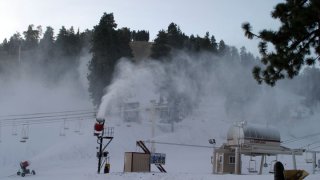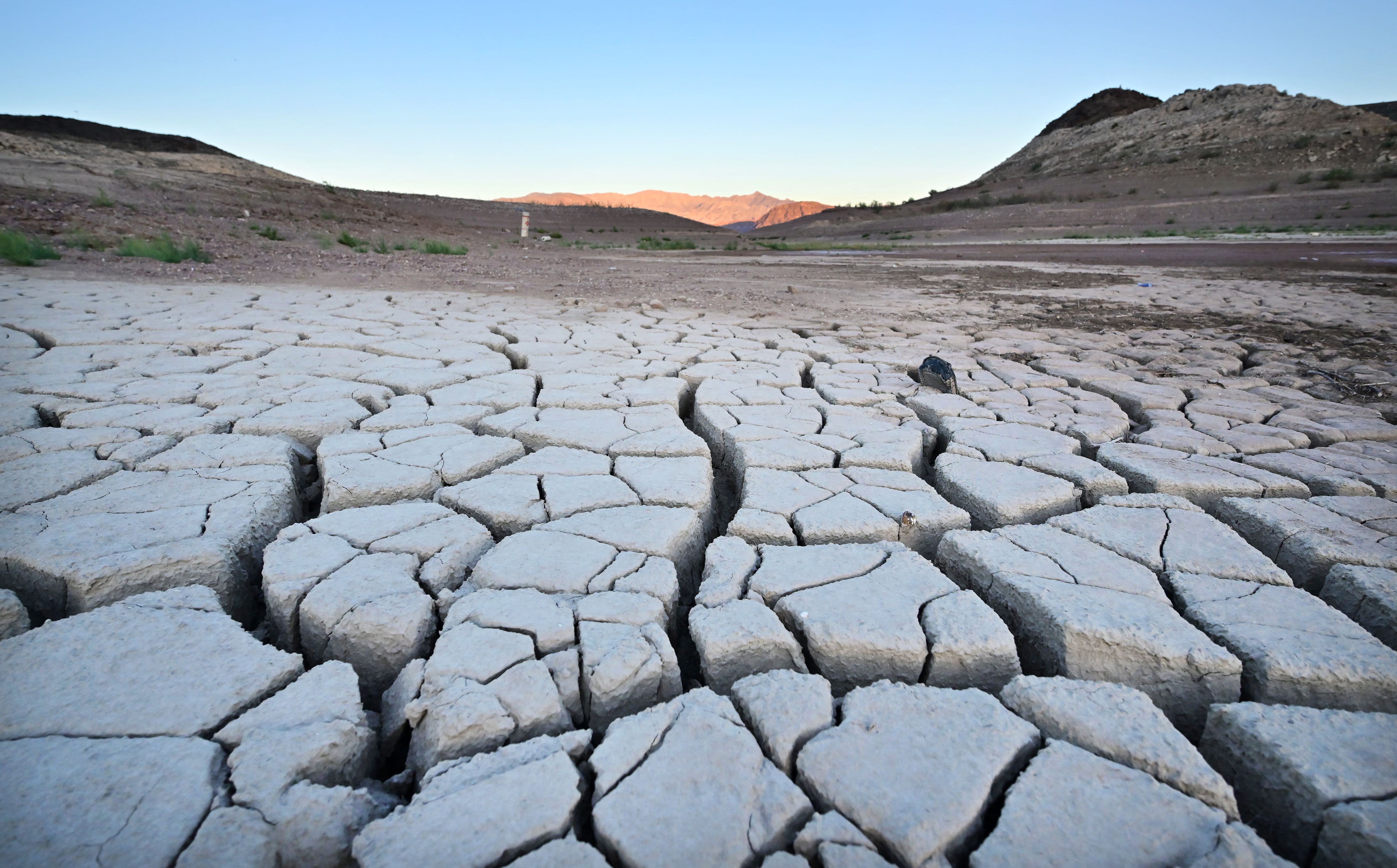
Snow falls thick as skiers shed their gear and duck into the Sundeck Restaurant, one of the first certified energy efficient buildings in the U.S. – this one at 11,200 feet above sea level atop Aspen Mountain in Colorado. Skiers in brightly colored helmets jockey for a spot at the bar, their bodies warmed by thick, insulated walls and highly efficient condensing boilers.
Overhead, WeatherNation plays on the television, looping footage of last year’s mega storms and flashing a headline: “2022 billion dollar disasters.”
Aspen Skiing Company's vice-president of sustainability, who sits nearby eating a slice of pizza, says it's not enough for resorts to just change their on-site operations to become “green."
“If you’re a ski resort and you care about climate change or you profess to care about climate change, it absolutely has to go beyond reducing your carbon footprint,” said Auden Schendler. “If your CEO hasn’t spoken out on climate publicly or in an op-ed, you’re not a green company.”
Get top local stories in San Diego delivered to you every morning. Sign up for NBC San Diego's News Headlines newsletter.
As global warming threatens to put much of the ski industry out of business over the next several decades, resorts are beginning to embrace a role as climate activists in the halls of government. The industry contributes just a tiny fraction of overall greenhouse gas emissions, which cause climate change, but arguably has outsized influence on popular culture and in the business world. While many resorts are focused on reducing their own emissions, others are going much further, leveraging their influence to shift public opinion and advocate for climate legislation.
Arapahoe Basin is a ski area leading such efforts in the United States. Positioned high up on the craggy, wind-whipped continental divide in central Colorado, the mountain is relatively well-positioned to endure a warmer, shorter winter season. High altitude, which keeps temperatures cooler and lengthens the time snow stays on the ground, is its golden ticket. But it isn’t immune to extreme weather: it has experienced close calls with wildfires and subsequent mudslides, which washed out a parking lot adjacent to its slopes in 2021.
US & World
About a decade ago, the ski area transitioned from spending thousands of dollars annually to cancel out some carbon emissions by paying for carbon credits to instead funding a staff position focused on reducing on-site emissions.
“If we are gonna ask our guests to be better, we’re gonna ask our guests to talk to their leadership, we’re gonna go talk to our leadership directly, we definitely feel like we need to be doing it too,” said Sustainability Manager Mike Nathan.
One way they're working to nudge a transition to renewable energies is with newly installed electric vehicle chargers. After a day on the slopes, Denver resident Kurt Zanca returned to his Tesla, which had been charging for free at one of the five dual-port stations situated in the front row of the mountain's parking lot.
Zanca said he thinks charging infrastructure at ski areas can help encourage hesitant shoppers to purchase an EV. “If you can drive up here, charge, go back, no problem, it makes it a lot easier,” Zanca said.
In the northern French Alps, luxury chalet operator Alikats also sees incentives for customers as a catalyst for change. They offer discounts to guests who travel by train, opt out of eating meat or don't use a hot tub during their stay.
Al Judge, who owns and operates the business with his wife Kat, considers himself a realist. He’s not trying to save snowfall—massive reductions in greenhouse gases emissions worldwide are needed to slow global warming—but rather set a standard for how businesses should operate in a way that respects natural resources and protects biodiversity.
“The more that becomes a cultural imperative, the quicker change will happen, and I think business has a very important role to play in that process,” Judge said.
Arapahoe Basin, affectionately known by locals as “A-bay,” is working toward net-zero emissions by 2025, partially by relying on credits through the Colorado Carbon Fund to offset some natural gas and diesel they'll still be burning at that time. They also aim to divert 75% of their waste by then — they're currently at 50% through various recycling and composting programs. Nathan says these efforts give them clout when trying to flex their influence off the mountain.
They've pressured their utility, Xcel Energy, to expedite the transition to renewable power. Earlier this year, Nathan and other industry leaders met with the governor's staff to encourage the rapid transition to manufacturing EV heavy machinery statewide. And, after watching a federal bill that eventually became the Inflation Reduction Act stall, Nathan and Chief Operating Officer Alan Henceroth co-authored an op-ed and sent letters to Colorado’s congressional delegation.
“Kicking the can for another legislative session was going to have direct and negative impacts on businesses like us,” Nathan said.
Similarly active in policy work, Judge runs an organization that's studying the lack of public transit in the region and expects to soon lobby French officials for a solution. A train route through the northern Alps would provide a more direct public transit option that could reduce the number of flights coming in, Judge said.
Customer travel remains a primary source of pollution for ski areas, with air travel, in particular private jets, a major culprit. For example, over 80 percent of flights in and out of Aspen-Pitkin County Airport are private jets, airport officials said. Ideally, airports could tax private jets and invest that money in renewable energy projects, said Schendler. But the Federal Aviation Administration remains a roadblock. Federal law prohibits airports from spending tax revenue offsite. This restricts any renewable projects to airport grounds, and any revenue made from them must be used exclusively at the facility.
While Aspen has yet to win over the FAA, it found a way to sway its local utility, Holy Cross, which supplies power to more than a dozen towns in addition to Vail Mountain Resort along the Interstate-70 corridor. About 15 years ago, Schendler began phoning environmentally minded locals and encouraged them to run for board positions for the utility, which produced about 10% renewable electricity at the time. Today, the board is stacked with pro-renewable members, largely the fruit of lobbying by Aspen and other activists. The utility is split about 50/50 between renewables and fossil fuels, and is committed to 100% renewables by 2030.
Another way to speed the transition to renewables is through power purchase agreements. This is when a business or utility commits to buying a set amount of energy from yet-to-be-built projects, guaranteeing some of the funding to be built.
Vail Resorts, which owns 37 ski areas in three countries, has done this with a wind farm in Nebraska, and is one of five partners for a new solar array in Salt Lake City. Power purchase agreements have helped Vail reach 100% renewable electricity for all its resort and ski areas in North America, and 96% internationally.
Snowshoe Mountain is a ski resort in West Virginia still largely powered by fossil fuels. As the climate bill stalled last summer in Congress, CEO Patti Duncan felt the need to get involved. She doesn't consider herself an activist but wanted to speak up when she watched one of her state’s senators, Joe Manchin, defend the state’s coal industry and hold up the legislation. Duncan wondered, what about the thriving outdoor industry, which is negatively impacted by the burning of fossil fuels?
With encouragement by owner Alterra Mountain Company and climate activist group Protect Our Winters, she wrote a letter to Manchin. Days later, he came out in support of the bill. Duncan said she doesn’t know whether her letter played a role in the senator’s decision but is glad she spoke up.
“It’s my responsibility to do something about it for our resort and our community and our state,” Duncan said.
On the other side of the country, Aspen had installed a kiosk at its Limelight Hotel lobby at the base of Snowmass Mountain. The kiosk allowed guests to send a pre-paid card to the senator, encouraging him to support the bill.
The climate bill passed and was signed into law. As a result, record federal funding is now available for households and businesses to decarbonize buildings and transportation. But Mario Molina, executive director of Protect Our Winters, says the work is just getting started.
Also in the News
The next steps are “anything and everything that resorts can engage in to leverage not only their political power but also their power as large consumers to help implement and realize the promise of the Inflation Reduction Act,” Molina said. He cautioned of local opposition to renewable energy projects, and said resorts could make a big impact advocating for the permitting necessary for those projects, in addition to taking advantage of every available credit on their own.
Many skiers applaud such efforts and want their favorite ski areas to have a role in fighting climate change — with an important caveat.
“As long as they’re being sincere and not just sort of doing it for show and not actually making much of a change,” said Archie Bolgar, a British student on vacation at Aspen in January with friends from Boston’s Bentley University.
While there are many environmental issues corporations could embrace, Schendler says the focus must be on reducing emissions to make sure global temperatures don't rise more than 2 degrees Celsius or 3.6 degrees Fahrenheit compared to preindustrial times. The rise is currently about 1.1 degrees Celsius or 2 degrees Fahrenheit, and climate scientists warn that as it increases so too will extreme weather events.
“If we can stabilize warming at sub 2 degrees Celsius, we’re going to prevent billions of people from suffering. That’s profound,” he said.
The Associated Press receives support from the Walton Family Foundation for coverage of water and environmental policy. The AP is solely responsible for all content. For all of AP’s environmental coverage, visit https://apnews.com/hub/climate-and-environment







